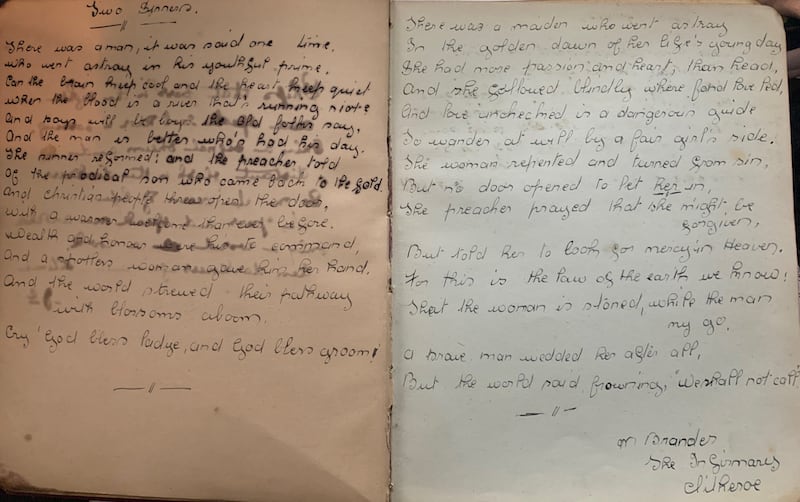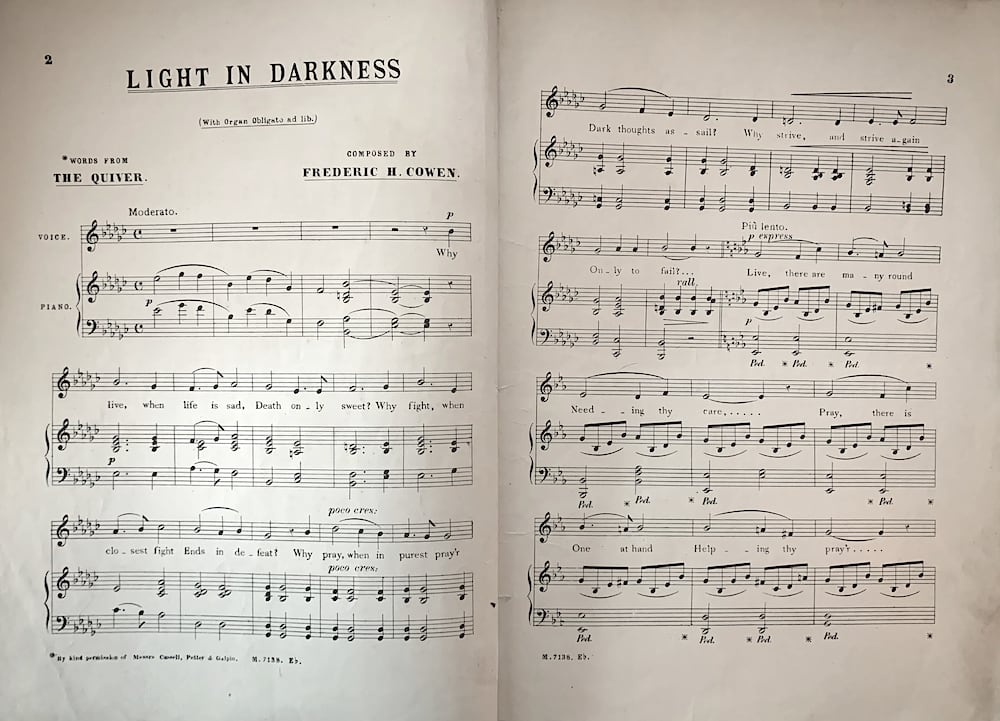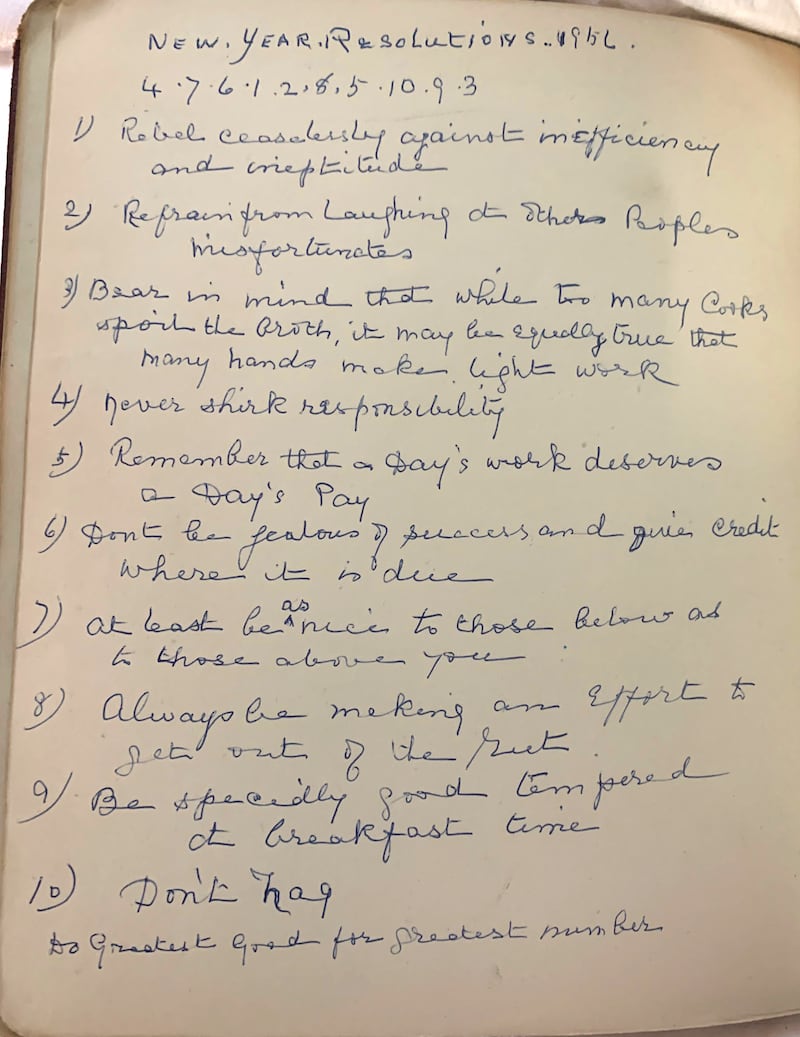Ephemera: The Notebook of Jeannie Clegg
From my search to track down First World War soldier-drawn cartoons for my dissertation, and the route through which I acquired items, I ended up with quite a collection of war-related ephemera (which is still growing). It seems a shame for it to just sit in boxes so I thought I would try and do something interesting — and hopefully useful — with them. My plan is to build an archive from my collection, put it up on the web under a creative commons licence, and try and create a model around it to see what insights can be gained.
In terms of modelling, I am taking a similar approach to the one I used during my dissertation, which involves finding a way to construct and categorise a matrix onto which the items can be plotted so they can be compared. The one I built for cartoon analysis consisted of 11 categories and, including metadata, 208 datapoints, which took over eight months to build and populate. Ephemera such as autograph books are several degrees more complicated to model so this is going to be a slow project. I also know from experience that it will take several attempts to get the framework right so I wanted to start with something quite basic to set the foundation. As such, I have chosen a notebook*, originally belonging to Jeannie Clegg, from Clitheroe, as it only contains two pictures, and is quite wordy.
Jeannie Clegg's Notebook

I have been unable to identify who Jeannie Clegg was, and other signatures in the book have been equally elusive, but I have been able to identify one individual: a Margaret Brander of Whittingham who was employed as a nurse by the Clitheroe Guardians on 9 February 1916 (see Figure 3).1 The Clitheroe Guardians were a body that oversaw the Clitheroe Union workhouse, originally located on Chatburn Road, which accommodated 200 inmates along with a 36-bed hospital.2
The book contains 29 entries, very few of them dated and the ones which are, with one exception (see below), are dated 25 January 1917. These entries were made by an S. Booth of the Giggleswick Union (Figure 2), an Edward of the Settle Union, as well as a Millie Gel. This lends me to believe that this was a gift (a leaving gift perhaps?). The other entries appear to be in the same hand (presumably Jeannie Clegg's) and the book was used to record poems, passages, and recitals.

The aforementioned Margaret Brander copied into the book the poem Two Sinners by the American poet Ella Wheeler Wilcox (1850-1918) (Figure 3).

Two Sinners (Transcript)
There was a man, it was said one time.
who went astray in his youthful prime
can the brain keep cool and the heart keep quiet
when the blood is a river that's running riots
and boys will be boys the old folks say.
and the man is better who had his day.
The sinner reformed and the preacher told
of the periodical son who came to the fold
and Christian people thew open their doors,
with a warm welcome that ever before
wealth and honour were his to command
and a spotless women gave him her hand
and the world strewer their pathway
with blossoms boom
By "God bless lady, and god bless groom!"
There was a maiden who went astray,
In the golden dawn of her life's young day;
She had more passion and heart than head,
And she followed blindly where fond love led.
And love unchecked is a dangerous guide,
To wander at will by a fair girl's side.
The woman repented and turned from sin;
But no door opened to let her in.
The preacher prayed that she might be forgiven,
But told her to look for mercy---in heaven;
For this is the law of the earth we know,
That the woman is stoned while the man may go.
A brave man wedded her after all;
But the world said, frowning, "We shall not call".
M. Brander
The Infirmary
Clitheroe
Ella Wheeler Wilcox was a poet who enjoyed a high level of popularity in England at the time. The Common Cause, a magazine created in support of the National Union of Women's Suffrage, ran a posthumous article in 1920 titled 'Why Ella Wheeler Wilcox Appeals to the Ordinary Woman' concluding:
One reason for this was the mighty optimism of the poetess. Her message may be summed up as a clarion to humanity to rise above the doubts and fears of life, and face the future dawn of a brighter and better era.3
There are at least two occurrences of the poem being recited at benefit concerts: one for the Derby Pals in April 1916 and another for the Methodist church 'Circuit Fund' in July 1916.4 On a sidenote, as this blog has the dual purpose of also serving as my notebook, I noticed something quite interesting about how Wheeler books were advertised during the war (Figure 4). The advert on the left is from 13 December 1916, published in the Truth magazine, while the one of the right was published on 1 December 1917 in the Sphere.

Note the inclusion of populistic rhetoric in the second advert, which is no accident. At the start of the war, propaganda did not have the negative connotations it has today, instead 'It was a form of national advocacy or advertising, whereby the government sought to make the best case at home and abroad for itself and its prosecution of the war.'5 This changed, arguably, in the spring of 1915 with the sinking of the Lusitania and the release of The Bryce Report — a flawed attempt to document the atrocities being carried out by German soldiers in Belgium.6 From this point onwards, propaganda began to take on a much darker tone and by 1917, when the country was entrenched with war-weariness, it had morphed into a populist-driven issue with the negative connotations associated with propaganda today having firmly taken root.

Returning to Jeannie Clegg and her entries, they seem mainly to stem from American authors such as Frank Walcott Hutt and Mary Torrans Lathrap. They are all quite evangelical in nature, and well-travelled — having appeared in a variety of publications on both sides of the Atlantic.7 One of these entries is a song entitled 'Light in the Darkness'. The earliest mention of this I could find was in an 1883 book, The Onward Reciter: A Choice Collection of Recitations, Readings and Dialogue, where it was published under an alternative title, 'Live and Work'.8 I also came across a reference to it in a concert programme from 1892, in the Palace Journal, a weekly magazine connected to the Queens Hall Peoples Palace, Mile End, where it was reported to have been set to music by the composer Frederick Cowen.9 By pure coincidence, I managed to pick up a copy of the sheet music (Figure 5) and, having converted it to a midi file, I think it is fair to say it is a bit overdramatic and not exactly a foot-tapper. The song starts with funeral march seriousness, to which the line 'Why Live, when life is sad, death only sweet?' is sung before breaking into a sickly floral up-tempo chorus with the words 'Live, There are many round needing thy care'.
Another observation when transcribing the book is that in some of the poems there was a word that had been changed, or a sentence that had been re-arranged. At first, I thought this was just an error, but I think this might have been done to change the meter so it could be recited to music, which leads me to believe Jennie Clegg may have been a Methodist, involved in a choir, and used this as a notebook for recitals.
There is one final entry of note, and I will leave this one to the storytellers out there: it is an entry made some 38 years later, written in biro with a shakier hand, and is a new year's resolution list for 1956 (Figure 6).

The Technical Bit

You can find the github depository here
For each entry, I just want to record a few thoughts on building the model, and where it is going. As this is the first such entry — and in relation to my note above about how this is going to involve some going back and forth — I will keep this brief for now.
For consideration, and to return to the asterix above, I am cataloguing this artefact as a notebook, but as can be seen from Figure 1, the book itself is titled an 'Album', and it acts as an autograph book. While this is not a problem at this stage, as the database gets bigger, it is important not to lose focus on small intricacies like this.
In terms of set up, there is a Master Record spreadsheet which will hold a line for each individual entry along with the metadata. For now, I would not pay too much attention to column headings as they will change.
For each item in the collection, there will be an individual folder with a text file for each page — this is something I wish I had done on my cartoon model as it makes life easier than trying to keep the text alongside the Master Record.
I am using RStudio to run the analysis. Not much here at the moment, but I have included a script which creates the word cloud in Figure 7 and shows all the words, except stop words, used in the book — it is a surprisingly small lexicon of just 475 words. Going forward, once other entries are up here, it will be possible to see how it compares, as well as to run some more advance analysis around language and emotion — I am especially keen to see if there are any notable changes in 1917 when war-weariness kicked in.
A note on images: I want to invest in some better equipment for photographing my items. Some of the items I have are quite delicate, so I only want to photograph them once. Until I do, most of what is in the archive is text-based.
Finally, as mentioned, I am putting my collection, and the model, up under a creative-commons licence type 4 (CC BY NC 4.0).
See https://creativecommons.org/licenses/by-nc/4.0
This means, you are free to:
-
Share --- copy and redistribute the material in any medium or format
-
Adapt --- remix, transform, and build upon the material
The licensor cannot revoke these freedoms as long as you follow the license terms.
Under the following terms:
-
Attribution --- You must give appropriate credit, provide a link to the license, and indicate if changes were made. You may do so in any reasonable manner, but not in any way that suggests the licensor endorses you or your use.
-
Non-commercial --- You may not use the material for commercial purposes.
-
No additional restrictions --- You may not apply legal terms or technological measures that legally restrict others from doing anything the license permits.
This applies to material published on the git-hub depository only, and does not apply to this website.
-
Burnley Express, Wednesday 9 February 1916. ↩︎
-
https://www.workhouses.org.uk/Clitheroe/ retrieved 24 February 2023. ↩︎
-
Common Cause, Friday 15 October 1915. ↩︎
-
Liverpool Daily Post, 17 May 1916; Bucks Herald, Saturday 1 July 1916. ↩︎
-
S. Badsey, The German Corpse Factory: A Study in First World War Propaganda (Warwick: Helion & Company, 2019), The German Corpse Factory, p.16. ↩︎
-
Badsey, The German Corpse Factory, p.85. ↩︎
-
Painter and Decorator: Brotherhood of Painters, Decorators and Paperhangers of America, The Branksome Slogan 1948. ↩︎
-
The Onward Reciter: A Choice Collection of Recitations, Readings and Dialogue (London: Partridge & Co, 1883), p.79. ↩︎
-
The Palace Journal, 22 January 1892, p.59. ↩︎